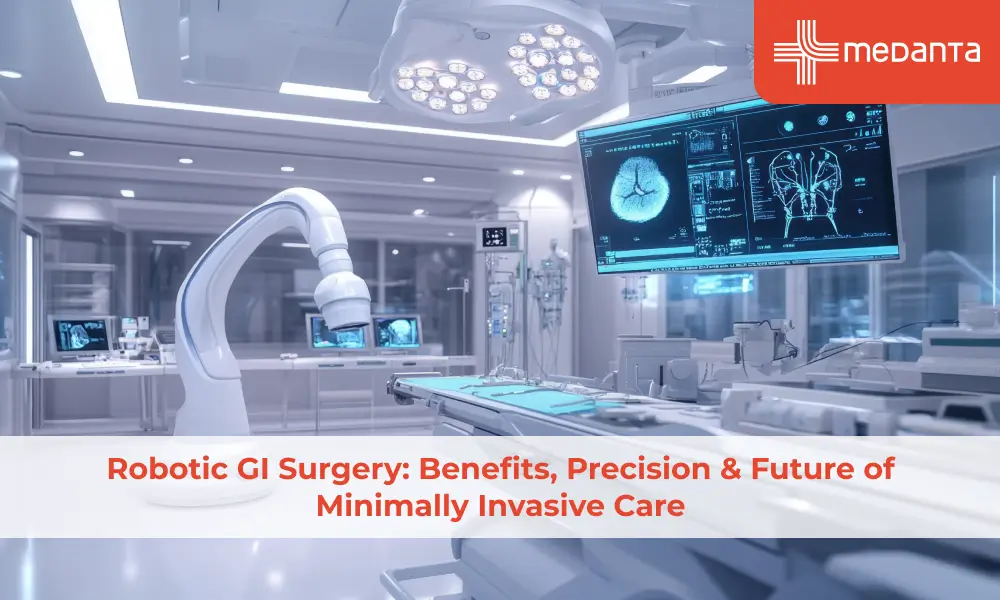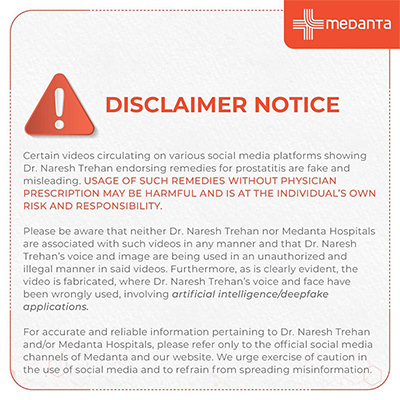Robotic GI Surgery: Benefits, Precision & Future of Minimally Invasive Care

TABLE OF CONTENTS
Robotic surgery, also known as robot-assisted surgery, involves performing surgical procedures with the assistance of robotic devices. This advanced technique offers several advantages over traditional minimally invasive surgeries, providing surgeons with improved control over surgical instruments and a clearer view of the operative site.
One significant benefit of robotic surgery is the enhanced control over the placement of the laparoscopic camera, which remains steadier with fewer inadvertent movements compared to human assistance.
Moreover, the robot's computer program filters out natural vibrations, further improving precision during the procedure. Another advantage is that the robotic system can be used by multiple surgical teams without experiencing fatigue, making it a reliable tool for various surgical rotations.
What is Robotic Technology in GI Surgery?
Robotic technology in gastrointestinal (GI) surgery refers to the use of robotic systems to assist surgeons in performing minimally invasive surgical procedures within the GI tract. These systems consist of robotic arms equipped with precise instruments and cameras, controlled by the surgeon through a console.
The robotic arms are inserted into the patient's body through small incisions, allowing the surgeon to operate with enhanced precision and maneuverability.
Robotic technology enhances the surgeon's capabilities, providing magnified, high-definition views of the surgical site and allowing for intricate maneuvers with minimal tissue trauma. This advanced approach offers numerous benefits, including improved surgical outcomes, reduced recovery times, and enhanced patient comfort.
Benefits of Robotic Technology in GI Surgery for Patients
Robotic technology in gastrointestinal (GI) surgery offers several benefits for patients, enhancing their overall surgical experience and outcomes. Here are some of the key advantages:
Minimally Invasive Procedures: Robotic GI surgery enables minimally invasive procedures, which involve smaller incisions compared to traditional open surgery. This results in less postoperative pain, reduced scarring, and faster recovery times for patients.
Enhanced Precision and Accuracy: The robotic system provides surgeons with enhanced precision and accuracy during GI procedures. The robotic arms can make precise movements and maneuvers in tight spaces, allowing for delicate procedures with minimal tissue damage.
Improved Visualization: Robotic technology offers high-definition, three-dimensional visualization of the surgical site. This enhanced visualization enables surgeons to see the anatomy in greater detail, improving their ability to identify and navigate structures within the GI tract.
Reduced Complications: The precise control offered by robotic systems can help reduce the risk of complications during GI surgery. With greater precision, surgeons can avoid inadvertent damage to surrounding tissues and organs, lowering the risk of complications such as bleeding and infection.
Shorter Hospital Stays: Patients undergoing robotic GI surgery often experience shorter hospital stays compared to traditional open surgery. The minimally invasive nature of robotic procedures allows for quicker recovery, enabling patients to return home sooner and resume their normal activities.
Quicker Recovery: Robotic GI surgery typically involves less trauma to the body, resulting in quicker recovery times for patients. Patients may experience less postoperative pain and discomfort and can often resume their normal activities sooner after surgery.
Improved Quality of Life: By offering less invasive procedures with faster recovery times and reduced postoperative pain, robotic GI surgery can significantly improve patients' quality of life. Patients can return to their daily routines more quickly, experiencing less disruption due to surgery.
Benefits of Robotic Technology in GI Surgery for Surgeons
Robotic technology in gastrointestinal (GI) surgery provides numerous advantages for surgeons, enhancing their ability to perform complex procedures with precision and efficiency. Here are some benefits of robotic surgery for surgeons:
Enhanced Precision and Control: Robotic systems offer surgeons greater precision and control during GI procedures. The robotic arms can make highly accurate movements and maneuvers, allowing surgeons to perform intricate tasks with greater ease and accuracy.
Improved Visualization: Robotic GI surgery provides high-definition, three-dimensional visualization of the surgical site. This enhanced visualization enables surgeons to see the anatomy in greater detail, facilitating better decision-making and surgical planning.
Steady Camera Placement: Robotic systems offer steady camera placement, with fewer inadvertent movements compared to human assistance. This steady camera view enhances the surgeon's ability to navigate and manipulate instruments within the GI tract, improving overall procedural efficiency.
Reduced Physical Strain: Robotic technology helps reduce the physical strain on surgeons during lengthy procedures. Surgeons no longer need to stand for extended periods, as they can control the robotic system from a seated console. This can help prevent fatigue and discomfort, allowing surgeons to maintain focus and precision throughout the surgery.
Greater Ergonomics: The ergonomic design of the robotic console allows surgeons to operate comfortably with natural hand movements. This ergonomic setup reduces the risk of repetitive strain injuries and musculoskeletal discomfort, enhancing the surgeon's overall comfort and well-being during surgery.
Advanced Instrumentation: Robotic systems offer advanced instrumentation, including articulating instruments with a greater range of motion. These specialized instruments enable surgeons to perform complex maneuvers with enhanced dexterity and control, improving surgical outcomes.
Real-time Feedback: Robotic platforms provide surgeons with real-time feedback on their movements and actions during surgery. This feedback allows surgeons to make immediate adjustments and corrections, ensuring optimal surgical performance and patient safety.
Continuous Innovation: The field of robotic surgery is continuously evolving, with ongoing advancements in technology and instrumentation. Surgeons have access to the latest innovations in robotic-assisted procedures, allowing them to stay at the forefront of GI surgical care and offer patients the most advanced treatment options available.
Conclusion
It is clear that robotic technology has brought about many advancements in the field of GI surgery. Its benefits for both patients and surgeons are undeniable. With precision, flexibility, and minimally invasive techniques, robotic surgery has revolutionized the way GI surgeries are performed.
Patients can experience quicker recovery times, reduced risk of complications, and improved outcomes. Surgeons can also benefit from enhanced visualization and control during procedures, leading to more accurate and efficient surgeries. As technology continues to advance, we can only expect further improvements in robotic surgical procedures.
So if you ever find yourself or a loved one in need of GI surgery, don't hesitate to seek out a super specialty hospital with access to advanced robotics – it could make all the difference in your recovery process.






